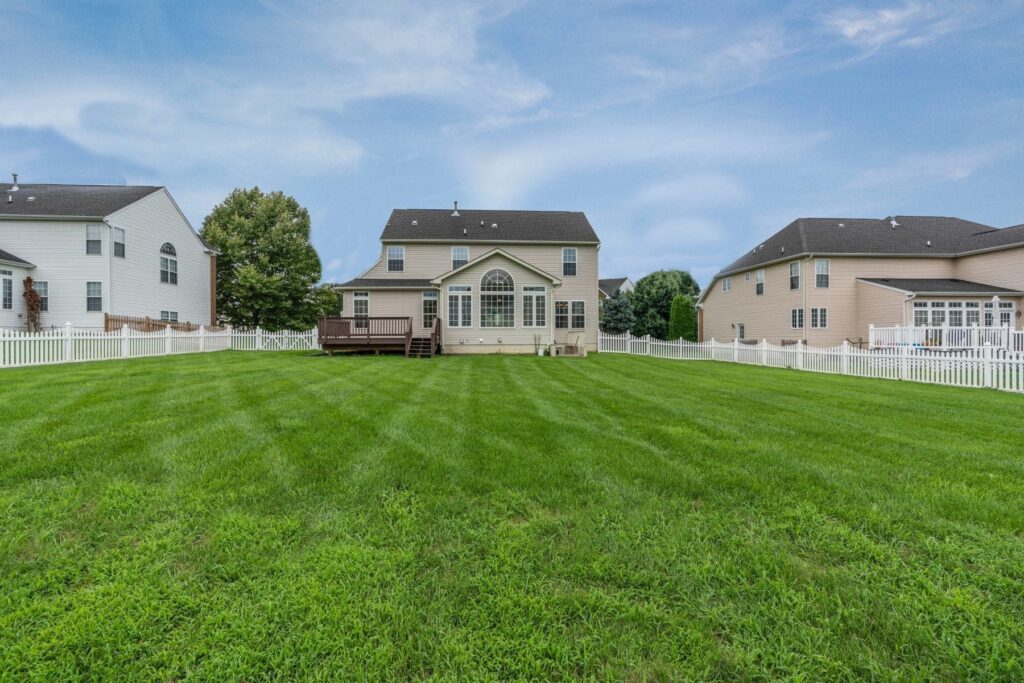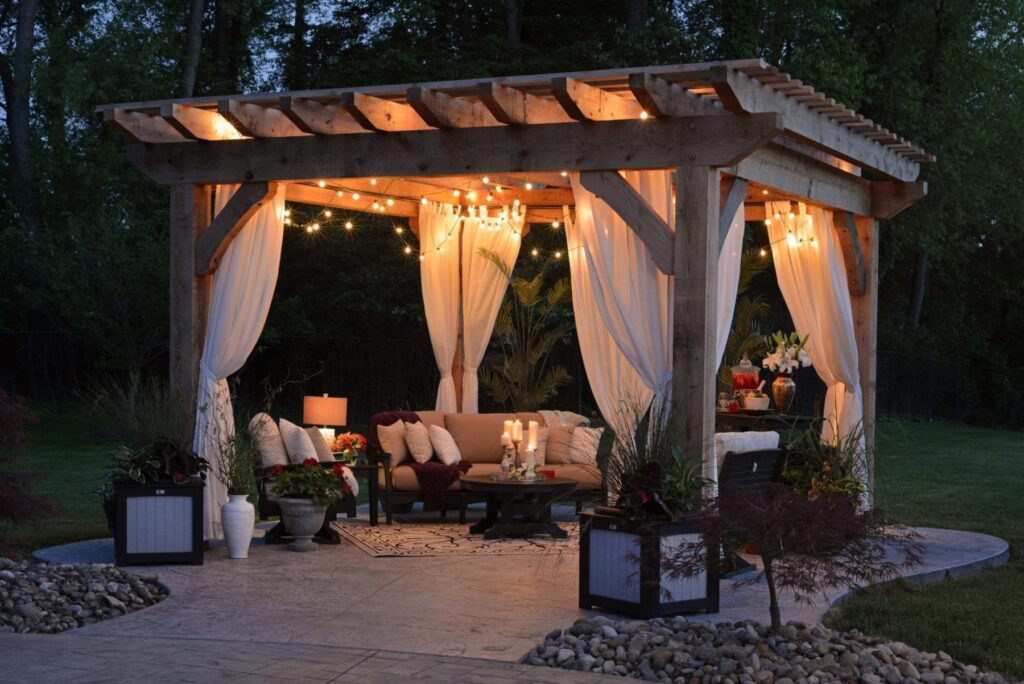 Winter season leaves everything barren and looking sad and empty – your backyard probably looks just like that after the last snow has finally melted down. And you probably can’t wait for it to look alive and colorful again.
Winter season leaves everything barren and looking sad and empty – your backyard probably looks just like that after the last snow has finally melted down. And you probably can’t wait for it to look alive and colorful again.
The backyard is an important element of every house, especially if there’s a chance that you will be selling your house at some point. The backyard should always look pristine and attractive because it impacts the impression potential clients will have. A combination of greenery, appealing landscape, and entertainment/seating areas in the right zone will make a great backyard. Now is the time to start introducing changes and preparing the soil – before the warm, spring days start.
1. Revive the lawn
The lawn is a must in many backyards, so if you have it, here’s how to revive it to have a lovely green carpet.
- Dry up snow mold – mold is a cold-season fungus that creates grey patches in areas where the snow had been. If you notice it, rake the lawn to loosen the grass and help it dry out. You may have to overseed the spot to fill it in with grass.
- Remove leftover deicing salt – if the winter was cold, the grass near driveways and sidewalks may be damaged from deicing salt. Apply a thin layer of granular or pelletized gypsum to replace the salt with sulphur and calcium, then water thoroughly. To avoid future damage, use cat litter or sand instead of salt.
- Remove thatch and aerate – remove the dead layer of debris from the base of the grass, then aerate, whether by hand with a manual core aerator or rent a gas-powered unit.
- Overseed – after aeration, spread a layer of compost and rake it in the grass, then overseed. There will probably be sufficient rain in the spring but if not, water the new lawn every day until it’s filled in (about 6 weeks).

2. Tend the garden/the greenhouse
In case you have a garden or a greenhouse in the backyard, it’s time to check on your vegetables. First, you should protect the vegetable pat and help it recover after the winter.
- Use black polythene to cover the beds and speed up soil warming.
- Apply chicken pellets or organic matter and know that a worm population is a sign of a healthy veg patch.
- Get a cloche to create a microclimate, which will warm up the plants and protect them from the elements.
It’s also important to control the appearance of pests but to do it in an eco-conscious way. Pests will resurface after the winter, eating out veggies instead of other food sources. Plus, there will be no natural predators at that time of the year.
- Use soapy water to fight aphids
- Use a natural ingredient bug killer to fight infestations
- Put up yellow sticky straps to attract bugs.
3. Create focal points with pathways
Every backyard should have a focal point, especially a small one. When people take a look at a small backyard, their eyes will focus on that point instead of scanning the area and realizing how small it is.
So, why not introduce some changes by making a pathway through the backyard using pavers or stones. They will create a sense of movement through the area. If you have more than one area in the backyard, pathways are even more necessary to lead to each of the areas.
Stepping stones are a simple and cheap way of creating paths – just distance them one from another and you’ll need fewer of them than you think.
4. Introduce vertical landscaping
If you haven’t tried it so far, now’s the time to start working on vertical landscaping in the backyard. It will add more greenery to the area without taking up much space, plus, it will appeal to potential buyers.
Make sure you use a variety of plants of different sizes that will add to the visual interest. Stoic perennials, shady trees, and ivy are great tall plants for this project but you should also include shorter plants – stack them up in planters and flower beds placed at different heights.
5. Use mulch or its alternatives
Mulch saves you time and water, and it also prevents weeds from spreading. And it gives a nice visual touch to the yard that lost its colors during the winter. However, mulch can be expensive, so here are some cheaper alternatives:
- Grass clippings – the next time you mow, rake up the clippings and savings and spread them onto the flower beds. You may have to wait a bit before the grass grows enough for mowing but it’s cheap.
- Leaves – there are probably leaves remaining on the ground during the winter season, so rake them up and shred them – they are great nutrients for the plants.
- Pine needles – if you have them in your backyard or close by, use them instead mulch.
- Compost– if you have a compost bin already prepared, use that for the plants; just make sure you don’t layer it too thickly.
6. Plant flowers and plants and choose them carefully
Period before the spring is the time to decide which new plants and flowers you will introduce to your backyard. By making a logical plan, you will fill your backyard with useful and thriving plants and flowers that will amaze anyone who sees it.
- Useful plants – first of all, it’s smart to cut grocery costs by planting vegetables and herbs. There are even certain herbs that repel bugs, making your backyard both lovely and functional.
- Fight weeds with perennials – you won’t need chemicals for killing weeds if you opt for dense perennial ground covers instead of having grass everywhere. Weed killers that you would have to use for protecting grass are costly and harmful to your health, while perennials are a safe and aesthetically pleasing choice.
- Bonsai tree for spiritual well-being and aesthetics – few plants are so elegant and artistic in its form like a bonsai tree. I would be a new, interesting element to your backyard that would be appreciated both by visitors and prospective buyers. Taking care of bonsai tree outdoors is easier than you think, and the effort will pay off – you will breathe in a new life into your barren backyard.
7. Add bold colors
To revive the backyard as soon as possible, add pops of colors around it. Flowers are not the only way you can do that. Use cushions and throw pillows to decorate the sitting area, add a bright-colored coffee table or hang a few red or bright yellow decorative items on the trees.
Of course, flowers in bloom are an excellent way to introduce color in a grey backyard. Try to create a theme by sticking to 2 or 3 colors and make a harmonious balance with them in the yard.
8. Build an outdoor fire pit
Building an outdoor fire pit is a great way to bring the family together and to convince future buyers that they will, too, have a wonderful time in the backyard with their closest ones.
You can make it a DIY project by popping to the home improvement store and build your fire pit in just a couple of minutes. If you have spare rocks from another project, you can put them to good use here. Here are a few suggestions:
- mixing stone and brick can be used together to create a fire pit that looks expensive but was cheap to build.
- you can outline the area where you want the fire pit to be, dig a hole and fill it with gravel, then build the fire pit by using landscaping stones or the fire-safe materials.
9. Install lighting
Nothing is as magical and romantic as a string of outdoor lights hung on the trees or framing the seating area. They will inspire you to start spending your evenings in the backyard by spreading warm, twinkling light and creating a cozy atmosphere. There are many creative and cheap ways in which you can use outdoor lights for enriching your landscape:
- run lights from your house to a tree using an insulated cable and an eye bolt
- edge the flowerbeds with rope lights, so that the blooms are visible at night, too
- wrap strands around outdoor pillars to create stunning columns covered with light
- drape the trees with lights for a charming atmosphere

10. Build a patio
If you don’t have a deck or a patio, now is the right time to build one and create a perfect place to entertain guests and to spend relaxing afternoons with your family. Once you have it, you can equip it any way you want – you can stick to a table and a few comfy chairs only, or you can add a sofa, a barbecue or even basic elements for the outdoor kitchen.
You just have to lay down a concrete slab or build a wooden deck, then add any elements you choose.
11. Improve the fence
Some of the simplest and cheapest ways to improve the looks of your backyard after a cold, harsh winter is to deal with the fence. It may have gone shabby or weary, and a few tricks will make it pop and serve as a decorative item to the yard.
The quickest way is to repaint it in a color that matches the facade or gives a lovely contrast to the greenery. You can also hang signs onto it, as well as flowers and planters, and even string lights.

12. Declutter your backyard
We all tend to pile up things we don’t need inside our homes and in the yard. The backyard serves as an open shed for a lot of things we don’t need during the winter, both inside the house and outside. So, when winter approaches its end, we suddenly realize our backyard is filled with broken things, appliances we rarely use or simply some old things we can’t bear to say goodbye to.
That’s why you should book a weekend for getting rid of that stuff from the backyard. be honest with yourself and keep the things that you are sure you will use soon. The rest of it should go either on the landfill, to a recycling facility or to be given to a charity. After you’re done decluttering, the backyard will seem much bigger, allowing you to get a better insight into how you can use the space.
13. Recreation area
For those days when you entertain guests, it’s a great idea to create a recreation area now, when it’s still not possible to spend time outside. You can get rid of some grass, dig up a patch there and install, for example, a post to play horseshoes. It’s great fun for everybody, but, of course, you can use the recreation area for any other outdoor game, such as a human-sized board for chess or checkers.
14. Outdoor pizza oven
You’ll probably host a few barbecues when the spring comes, so why not make a nice surprise for the guest by building an outdoor pizza oven? Everybody loves pizza, and being able to prepare one in the yard and eat it while it’s still hot – there’s no better addition to a backyard.
Final words
This transitional period between winter and spring is the perfect time for changes. As you will spend more time outside as the weather gets warmer, it’s only natural you should focus on your backyard now and the ways of improving its looks and functionality.
Other Outdoor Real Estate Resources:
- Eileen Anderson provides some great springtime yard tips if you are selling your home this spring.
- Curb appeal is about first impressions. Leave your home buyers with a great first impression with Lynn Pineda’s article on curb appeal.
- Spring is upon us and it is a great time to get your home ready for sale. Bill Gassett shares some great tips to prepare your house no matter what season.
———————————————————————————–
Bio: Patrick Adams is a freelance writer and rock-blues fan. When he is not writing about home improvement, he loves to play chess, watch basketball, and play his guitar. More than anything, he loves to spend his time in his garage, repairing appliances and creating stuff from wood.




